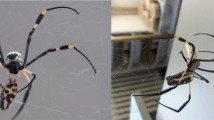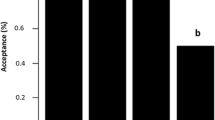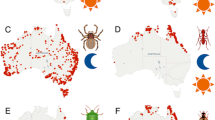Abstract.
Earlier studies have shown that the sarcophagid fly Arachnidomyia lindae is the principal egg-sac predator of the colonial orb-weaving spider Metepeira incrassata, and that risk of egg-sac loss increases with group size. Observations of specialized behaviors for attack (flies) and defense (spiders) suggest that this predator–prey relationship may incorporate elements of ploy and counterploy behavior. Here we explore this relationship in detail and test hypotheses regarding efficacy of attack and defense behaviors. Egg-sac guarding by the spider includes defensive behaviors specific to this fly predator, which were observed during experimental "attacks" with tethered A. lindae, but not with similar presentations of non-predatory Musca domestica. Experimental studies also show that Metepeira incrassata recognizes this predatory fly by airborne cues (i.e., the signature frequency of wing-beats), and can distinguish between this predator and other flies (potential prey) on the basis of wing-beat frequency differences. Removal of female spiders results in a significantly higher probability of unguarded egg-sacs being parasitized, demonstrating the adaptive value of spider defensive behaviors. We also present evidence that A. lindae utilizes a behavioral ploy for circumventing spider guarding behavior (aggressive mimicry – producing vibrations of captured prey in the web), and that Metepeira incrassata, in turn, exhibits a counter-ploy behavior (signal thread cutting) to eliminate this potentially distracting vibratory information. While previous studies have shown that this colonial web-building spider uses a number of general attack-abatement mechanisms against a diversity of predators and parasitoids, results of this study suggest that selection pressures from a highly specialized predator may also result in evolution of predator-specific prey responses.
Similar content being viewed by others
Author information
Authors and Affiliations
Additional information
Electronic Publication
Rights and permissions
About this article
Cite this article
Hieber, C.S., Wilcox, S.R., Boyle, J. et al. The spider and fly revisited: ploy–counterploy behavior in a unique predator–prey system. Behav Ecol Sociobiol 53, 51–60 (2002). https://doi.org/10.1007/s00265-002-0547-2
Received:
Revised:
Accepted:
Issue Date:
DOI: https://doi.org/10.1007/s00265-002-0547-2




